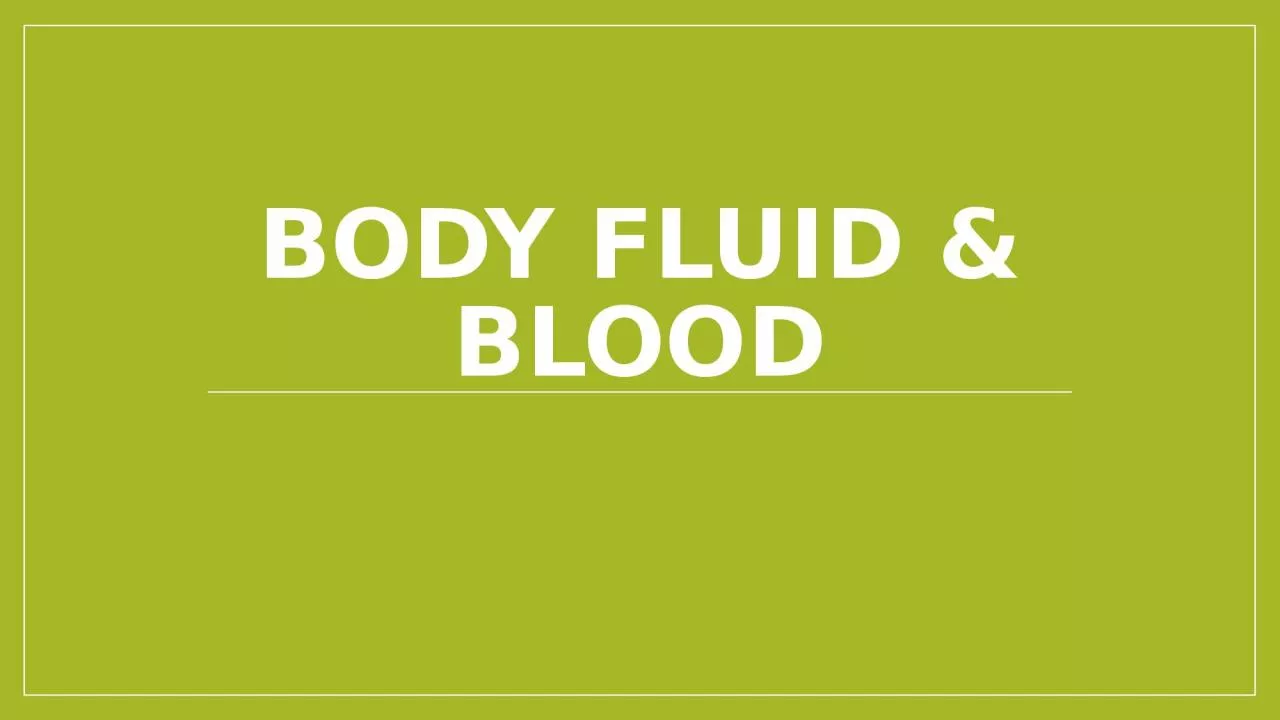

Blood is a specialized mature liquid connective tissue Total blood volume 6ltr pH of blood 74slightly alkaline Specific gravity 1055 Location circulatory system Blood plasma Straw colored fluid ID: 1039711
Download Presentation The PPT/PDF document "Body fluid & Blood Blood" is the property of its rightful owner. Permission is granted to download and print the materials on this web site for personal, non-commercial use only, and to display it on your personal computer provided you do not modify the materials and that you retain all copyright notices contained in the materials. By downloading content from our website, you accept the terms of this agreement.
1. Body fluid & Blood
2. BloodBlood is a specialized mature liquid connective tissue.Total blood volume- 6ltrpH of blood- 7.4(slightly alkaline)Specific gravity- 1.055Location- circulatory system
3.
4. Blood plasmaStraw colored fluidWater content-91.5%Solute content -8.5%Solutes contain proteins, electrolytes, nutrients, enzymes, hormones, gases, waste products ( urea, uric acid, creatinine, ammonia, bilirubin)Proteins found in plasma- plasma proteinPlasma proteins are synthesized by hepatocytesThey are albumin, globulin, fibrinogenAlbumin- smallest proteins, maintains osmotic pressure of bloodGlobulin- large proteins, produce immunoglobins ta attack against bacteria & virusFibrinogen- large proteins, helps in coagulation of bloodSerum= Blood plasma- fibrinogen
5. RBCRed blood cells or erythrocytesVolume in healthy male-5.4million/µlIn healthy female-4.8million/µlBiconcave discs of 7-8µmNo nucleus foundRed in color because of presence of hemoglobinEach rbc contains 280 million hemoglobinHemoglobin=heme(Fe2+)+globin proteinHemoglobin binds with 4 oxygenLife span-120days
6. Hemopoesis The process by which the cellular elements of blood develops- hemopoesisPrimary site of RBC synthesis- bone marrowThe process by which erythrocytes are formed- erythropoiesisBefore birth- yolk sac,liver,spleen, thymus, lymph nodeLast trimester- RBMAfter birth & through out the life- RBM
7. WBCKnown as leukocytesContains nuclei but not hemoglobinColorless cells containing nucleusLarger size than RBCVolume- 5000-10000 WBC/µl bloodLife span- few hours to few days
8.
9. Granulocytes WBCs have granules in the cytoplasmThey contain 2 or more lobesAgain divided into following 3 typesNeutrophilsEosinophilsBasophils
10. Neutrophils Smaller than othersPale lilac colorDo not attract either acidic or basic dyesNeutrophilic in nature2-5 lobes, connected by thin strands of nuclear materialOccupy 65-70% of total blood
11. Eosinophil Large, uniform sized granules which are eosinophilicEosinophilic- eosin loving- attract to acidic dyes-red or orange2 lobes connected by thin strands of nuclear material2-4% of blood
12. Basophils Round , variable sized granulesBasophilic nature- basic loving- blue purple dyes2 lobes, mostly kidney shaped0.5% of total blood
13. Agranulocytes Granules are not visible properlyPoor staining qualitySmaller in sizeAgain divided into 2 typesLymphocytesMonocytes
14. Lymphocytes Nucleus stains dark, round & slightly indentedCytoplasm stains sky blueMajor type of lymphocytes- T cell, B cell, NK cellFunction- deactivate the toxins, act against microbes, virus, bacteria etc.According to cell diameter 2 typesLarge(10-14µm)Small (6-9µm)
15. Monocytes Kidney shaped nucleusCytoplasm stains blue grey color & foamy appearanceMigrate from blood to tissue, enlarge, differentiate into macrophages. May be fixed or wondering.Clean up debris & microbes by phagocytosis after infection.
16. Development of WBC
17. Platelets 1,50,000-4,00,000/microl of bloodIrregular disc shaped2-4 micrometer diameterMany vescicles but no nucleusLife span 5-9 daysAged and dead platelets are removed by the fixed macrophages found in spleen & liverContains a no of chemicals that promotes blood coagulation.
18. Blood clottingA defense mechanism of body in which blood coagulates is known as blood coagulation or blood clotting.It is a series of chemical reaction.Several substances that involved in clotting is known as clotting factorThere are 13 no. of clotting factors present I human body.Avg clotting time is 5-15min.
19.
20. Mechanism of blood clotting
21. Blood groupingThe surfaces of erythrocytes contain a genetically determined classified antigens which is composed of glycoproteins & glycolipids.Antigens are called as agglutinogen.Basing upon the presence of antigens blood is differentiated into different groups.Major blood groups are: ABO & RhBlood plasma contains antibodies called as agglutinins that react with the antigens.
22. ABO Blood groupBased on 2 glycolipid antigens i. e. A & BAnti-A antibody reacts with antigen A and anti-B antibody reacts with antigen B.Antibodies do not react with the antigens of own RBCs.
23. ABO Blood group